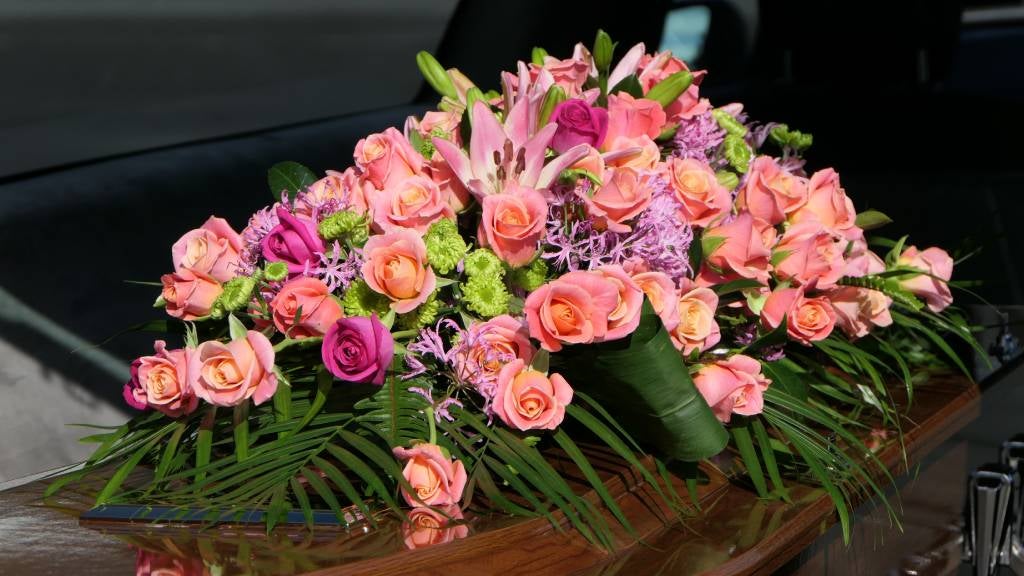Floral tributes: Funeral flower symbolism

Flowers are beautiful decorations for everything from weddings and birthdays, to anniversaries. Of course, they’re also common at funerals.
Aside from looking great and smelling even better, flowers also have their own language. Many flowers have their own meanings and symbolism, which can help to convey more than mere words could on their own.
To help us decode the meanings behind funeral flowers, we talked to Kate Hill, director at Kate Hill Flowers, for her expert wisdom.
Popular funeral flowers and their meanings
“Each flower holds a unique significance in funeral arrangements, providing comfort and expressing sentiment,” explains Kate.
Of course, lilies are perhaps the most well-known funeral flowers.
“Lilies are often chosen due to their connections with the restored innocence of the departed,” says Kate.
Roses are also a popular choice, but their meaning is attached more to the colour of the rose than the flower itself.
“White roses symbolise reverence and humility, whereas red roses express love and respect.”
There are even some places in the world that exclusively use chrysanthemums at funerals, as they represent death and grief.
“Other popular choices include carnations, which symbolise remembrance, eternal love, and gladiolus, which convey strength and moral integrity.”
Kate goes on to explain that at the end of the day, the choice of flowers should reflect the personality of the person you are saying goodbye to. That could mean bright yellow sunflowers for the bubbliest, happiest person you knew, or even a spray of wild flowers for someone who loved the natural outdoors.
Cultural traditions and flower choices
Many cultures have specific and respectful traditions when it comes to funerals and flower choices, and Kate has certainly seen plenty of it in her time as a leading florist.
“Throughout my career, I have observed that cultural traditions significantly influence funeral flower choices, infusing ceremonies with rich symbolism.”
This can depend a lot on where the person comes from, or their ancestry.
“In many Asian cultures, white flowers like chrysanthemums are prevalent, symbolising mourning and truth. In contrast, flowers such as lilies and roses are more common in Mediterranean countries, signifying purity and love, respectively,” she says.
And for those who were born and raised in Aotearoa?
“In New Zealand and Australia, native flowers like waratahs, eucalyptus, and flannel flowers are often chosen to pay tribute to the land and reflect the region's natural beauty.”
Maori traditions and funeral flowers
“In Maori culture, flowers are significant in funerals as they represent life, growth, and beauty. The most commonly used flower is the harakeke (flax plant), which symbolises strength and resilience,” says Kate.
But unlike European and Asian cultures, Maori funeral customs tend to use a lot more greenery, she adds.
“Ferns and other native plants are often incorporated into arrangements to symbolise connection and kinship with the land. These green elements also represent new beginnings and the cycle of life.”
At a traditional Maori tangi, you might even expect to see the use of taonga pūoro. These are musical instruments made from wood or other natural materials.
“These instruments are played to honour and guide the deceased’s spirit on their journey. I know this is not directly related to funeral flowers, but I also wanted to share this cultural aspect.”
Tips for choosing the right floral arrangement
Choosing the funeral flowers is just one small part of funeral planning in New Zealand. Yet it can be hard to know what to choose for funeral flowers, especially when there are so many decisions to make, and different flower meanings to consider.
“Personalisation is key when selecting a funeral flower arrangement. It is essential to consider the preferences and personality of the deceased while also keeping in mind cultural traditions and symbolism,” says Kate.
She suggests adding unique touches, such as including their favourite colour, or bringing in flowers that represent their interests. For someone who loves snowsports, you might use escallonia, the ‘snowbud’ flower, for example.
These touches can make an arrangement more meaningful and personal.
“Also, consider practical aspects such as the size and shape of the arrangement and any allergies or sensitivities of attendees,” suggests Kate.
Funeral costs
As well as being one of many decisions you’ll need to make when planning a funeral, flowers also represent one of many costs of a funeral. While you may be able to make some beautiful arrangements with flowers from your own garden, professional arrangements for caskets can cost into the hundreds.
Overall, funerals in New Zealand can cost as much as $10,000, which isn’t usually a sum that many can cover easily out of pocket. Which is why having funeral insurance can offer peace of mind in these situations. Visit our website to find out more about OneChoice Funeral Insurance.
2 Dec 2024